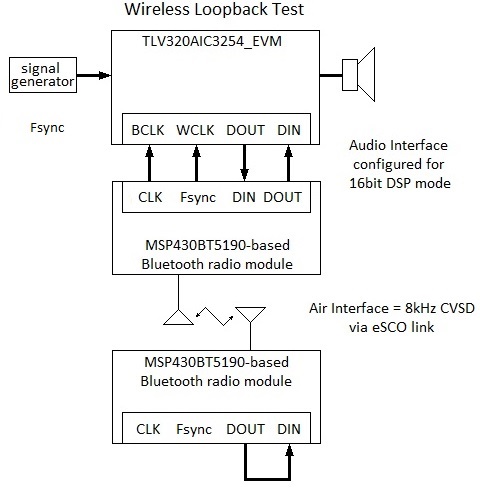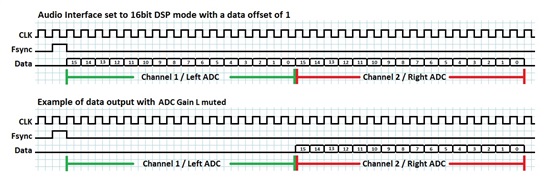Can the TLV320AIC3254_EVM be configured (using the AIC3254 CS tool) to to support the wireless loopback test shown below?
Local loopback works fine.
The intention is to use the AIC32x4 to support various local effects (i.e. amplifying, mixing, filtering, and more) while separately bandwidth limiting and transmitting voice data from a selected microphone source. Only voice data will be transmitted via the BT radio.
The wireless loopback test is intended as one type of validation of the voice data part of the system.
Local loopback tests (using both the digital loopback mode as well as a physical jumper on the EVM DOUT/DIN pins) have been successful. However, these tests used the default processing blocks, which don't appear to tolerate signal delays between the ADC and DAC sides (this is a guess). The wireless [BT] loop generates very large delays, and so I'd like to configure a pass-though without filtering for this test. Is this possible? Is there something else going on here that can be addressed?
In tests of the wireless loop, the data returned to the EVM appear to be good with only a small amount of jitter in the least significant bits. This jitter is probably due to the CVSD compression.
I am using the AIC3254EVM-K Control Software and have successfully configured the EVM for local loopback tests. PurePath Studio is available, but I have not yet used it to generate any configuration scripts. The immediate goal is to achieve the best possible signal reproduction in a simple wireless loop before adding processing elements.
Thanks,
Tim
This past weekend I searched the forums again, which helped me to address some minor issues (such as ringing related to insufficient oversampling). However, I haven't yet found any notes/comments on why data returned to the Audio Interface by a wireless loop does not produce the same output as when digital loopback is enabled. A clear tone is obtained during digital loopback, but the audio output obtained via the wireless loopback is highly attenuated and contains noise. Any ideas on what might be happening here? The clock and data signals between the EVM and the radio I2S/PCM interface are clean.
From 2009: TLV320AIC3204: How to route the I2S data from ADC to DAC?
http://e2e.ti.com/support/data_converters/audio_converters/f/64/t/2462.aspx
From 2013: Configuring AIC3204 for 8Khz Mono ADC and also DAC
http://e2e.ti.com/support/data_converters/audio_converters/f/64/t/268902.aspx



